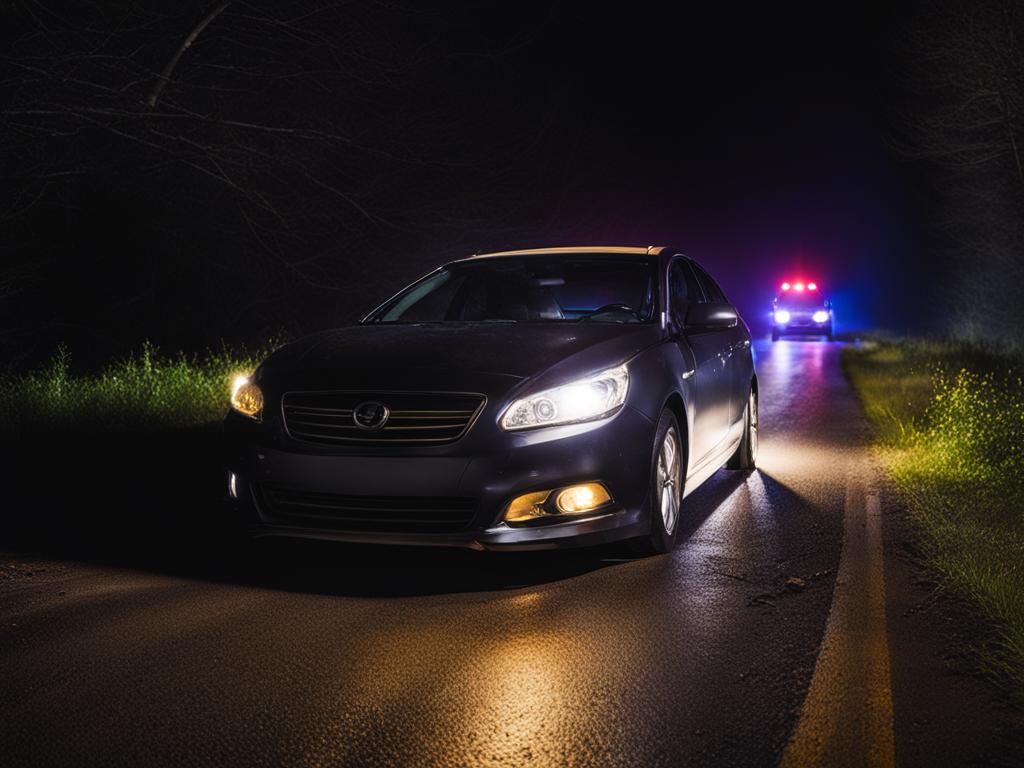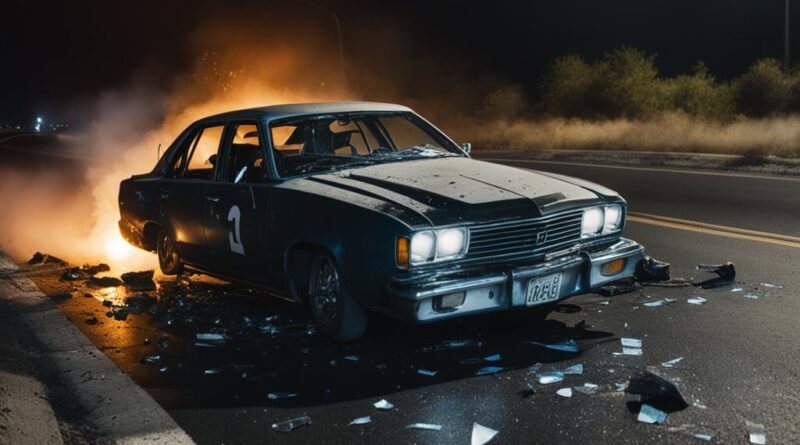Car Accident at Night: Staying Safe & Prevention
According to the National Highway Traffic Safety Administration (NHTSA), car accidents at night are a significant concern, with fatal accidents three times more likely to occur compared to the daytime. The combination of poor visibility and the presence of impaired drivers increases the risks on the road after dark.
In this article, we will explore the dangers of driving at night, provide essential tips for staying safe, and discuss strategies for nighttime driving. We will also highlight the importance of visibility and the risks associated with impaired driving. Lastly, we will touch upon seeking legal assistance if you’ve been involved in a car accident at night due to another party’s negligence.
Key Takeaways:
- Car accidents are more likely to occur at night, mainly due to poor visibility and impaired drivers.
- Staying safe while driving at night involves measures such as improving visibility, avoiding distractions, and being cautious of wildlife.
- Impaired driving, whether due to alcohol or fatigue, is a significant risk factor at night and increases the chances of car accidents.
- If you’ve been injured in a car accident at night, seeking legal assistance can help you navigate the legal processes and seek compensation for your injuries.
Tips for Staying Safe While Driving at Night
Driving at night can be challenging and risky due to reduced visibility and the increased potential for accidents. However, by following some essential safety tips, you can minimize the risks and ensure a safer journey. Here are some crucial tips for staying safe while driving at night:
- Avoid getting lost by using GPS or a map: Plan your route ahead of time and rely on navigation tools to minimize distractions and prevent last-minute turns that could lead to accidents.
- Lock your doors and turn off interior lights: Reduce visibility to the outside by locking your doors and turning off interior lights. This can deter potential intruders and enhance your safety while driving at night.
- Limit the use of cruise control: While cruise control can be convenient, it is safer to maintain full control of your vehicle at night. Responding quickly to unexpected situations requires your full attention and manual control.
- Improve visibility: Enhance your visibility by wearing glasses if needed and adjusting interior lights to a level that allows you to clearly see the road without causing discomfort or distraction. Properly utilizing headlights and high beams is also crucial for better visibility at night.
- Prevent breakdowns: Regular car maintenance is essential to prevent breakdowns that can leave you stranded on dark roads. Keep your vehicle serviced, check tire pressure, and maintain a sufficient level of gas to avoid unexpected issues.
- Limit distractions: Distracted driving is dangerous at any time, but it poses an even greater risk at night when visibility is compromised. Keep distractions to a minimum by avoiding phone use, eating, and any other activities that take your attention away from the road.
- Avoid drowsy driving: Fatigue can impair your reaction time and decision-making abilities. Take regular breaks during long drives, keep the car cool, and avoid driving when you are feeling tired or sleep-deprived.
By following these tips, you can greatly reduce the risk of a car accident at night and ensure a safer journey for yourself and others on the road.
The Dangers of Driving at Night
Driving at night can be significantly more dangerous than during the day. Reduced visibility and the increased risk of encountering impaired drivers pose serious threats on the road. Factors such as inadequate lighting, dimly lit roads, and the presence of drunk or drowsy drivers contribute to the heightened likelihood of car accidents at night.
One of the primary dangers of driving at night is reduced visibility. Without sufficient lighting, it becomes challenging to identify hazards, pedestrians, or other vehicles. This makes it difficult to react promptly and avoid collisions. Additionally, dimly lit roads can make it harder to see road markings, signage, and obstacles, further increasing the risks.
Impaired drivers add another layer of danger to nighttime driving. The presence of drunk or drowsy drivers on the road significantly raises the chances of accidents. Alcohol impairs judgment, coordination, and reaction time, making it more likely for intoxicated drivers to cause collisions. Fatigue can lead to drowsy driving, which slows down reaction times and impairs decision-making abilities, putting both the drowsy driver and others at risk.
“Nighttime driving presents unique challenges due to reduced visibility and the potential for encountering impaired drivers,” says John Thompson, a road safety expert. “Motorists need to be extra cautious to mitigate these risks and ensure their safety on the road.”
It is essential for drivers to remain alert, anticipate potential hazards, and adapt their driving accordingly when on the road at night. By taking necessary precautions and being aware of the dangers, drivers can reduce the likelihood of being involved in a car accident at night.

Increased Risk of Fatalities at Night
When it comes to car accidents, nighttime driving poses a significantly higher risk of fatalities compared to daytime driving. According to the National Highway Traffic Safety Administration (NHTSA), fatal accidents are more likely to occur at night. Let’s take a closer look at the statistics and factors that contribute to this increased risk.
One of the leading causes of fatal nighttime accidents is alcohol impairment. NHTSA reports show that the rate of fatal crashes involving alcohol is nearly four times higher during the night than during the day. Driving under the influence greatly impairs a driver’s judgment, reaction time, and overall ability to safely operate a vehicle.
Another contributing factor to the increased risk of nighttime fatalities is speeding-related crashes. With reduced visibility and potentially impaired drivers on the road, high speeds can significantly increase the chances of a fatal accident. It’s crucial for drivers to adhere to the speed limits and adjust their driving behavior to ensure their safety and the safety of others.
To illustrate the elevated risk of fatalities at night, consider the following statistics:
| Type of Crash | Percentage of Nighttime Fatalities |
|---|---|
| Alcohol-Impaired Crashes | Approximately 40% |
| Speeding-Related Crashes | Approximately 30% |
These statistics highlight the importance of exercising caution and being mindful of the increased dangers associated with nighttime driving. By understanding the risks and taking appropriate measures to stay safe on the road, we can help reduce the occurrence of car accidents and ultimately save lives.
Here are some tips to help reduce the risk of a car accident at night:
- Ensure your vehicle’s headlights are clean and in proper working condition.
- Maintain a safe distance from other vehicles.
- Minimize distractions and stay focused on the road.
- Avoid driving while fatigued or under the influence of alcohol or drugs.
- Obey traffic laws and speed limits.
- Use your high beams when driving in areas with low lighting conditions, but remember to dim them for oncoming traffic.
- Be cautious of pedestrians and wildlife that may be more active during the night.
Remember, staying safe on the road is a responsibility we all share. By taking precautions and being aware of the increased risks associated with nighttime driving, we can help prevent accidents, protect ourselves, and ensure the well-being of others.
Strategies for Nighttime Driving
To reduce the risk of car accidents at night, it is important to adopt certain strategies. Follow these tips to stay safe while driving after dark:
- Be extra defensive and alert: Due to the increased likelihood of encountering drunk drivers, it’s crucial to stay vigilant and anticipate potential hazards on the road.
- Combat fatigue: Take regular breaks, consume caffeine, or find a safe place to rest if you feel drowsy. Fatigue can impair reaction times and decision-making abilities.
- Ensure clear visibility: Regularly clean windshields and headlights to improve visibility. Clearer vision can help you spot obstacles and other vehicles more easily.
- Choose well-lit routes: Opt for routes that have adequate lighting and avoid two-lane highways with a higher chance of glare from oncoming headlights.
- Adjust speed according to visibility: Reduce your speed when visibility is low to allow for a longer reaction time in case of unexpected events.
- Correctly angle headlights: Maximize visibility without blinding other drivers by correctly angling your headlights. Ensuring proper headlight alignment is essential for a safer nighttime drive.
- Use high beams appropriately: When road conditions and traffic allow, use high beams to extend your visibility. If equipped, consider adaptive lighting systems in new cars for enhanced safety.
- Dim interior lights and use visors: Avoid distractions and glare by dimming interior lights and using visors to block direct light from coming into your eyes.
- Avoid fixed gazes: Refrain from fixating on oncoming headlights, as this can dazzle your vision and temporarily impair your ability to see the road ahead.
- Be cautious of wildlife: During dusk and dawn, be aware of the increased activity of wildlife near roads. Stay alert and maintain a safe distance from animals to avoid collisions.
- Maintain regular vision checks: Especially for age-related glare issues, it’s important to have regular vision checks to ensure optimal eyesight for driving at night.
- Regularly test and use all lights: Check and test all lights on your vehicle regularly, including low beams, high beams, turn signals, and brake lights, to maximize visibility and ensure other drivers can see you.
By adopting these strategies, you can significantly reduce the risk of car accidents at night and enhance your safety on the road.

The Importance of Visibility at Night
One of the key factors in preventing car accidents at night is maintaining good visibility. When driving in low-light conditions, drivers face increased risks due to reduced visibility. By taking certain precautions and ensuring optimal visibility, drivers can significantly reduce the chances of being involved in a car accident at night.
Maintaining Proper Lighting:
Proper lighting is crucial for navigating the roads safely at night. Here are some tips to ensure optimal visibility:
- Regularly check and maintain all vehicle lights, including headlights, taillights, turn signals, and brake lights. Replace any bulbs that are dim or burnt out.
- Keep windshields and headlights clean and free of dirt, dust, and debris. Dirty windshields and foggy headlights can impair visibility.
- Adjust headlights properly to ensure they are pointing in the correct direction and are not misaligned. Misaligned headlights can reduce visibility and blind other drivers.
By following these simple steps, drivers can improve their visibility on the road and minimize the risk of accidents.
Choosing Well-lit Routes:
Driving on well-lit roads significantly enhances visibility and reduces the chances of accidents. When possible, choose routes that are well illuminated with proper street lighting. These well-lit roads provide better visibility of the surroundings and obstacles, making it easier for drivers to react quickly and prevent collisions.
Being Prepared for Low-light Conditions:
Despite taking all possible precautions, drivers may still encounter dimly lit areas or sudden changes in lighting conditions while driving at night. In such situations, it is important to stay alert and adapt to the reduced visibility. Consider the following tips:
- Allow for increased following distances to provide more reaction time to unexpected obstacles or hazards.
- Reduce speed to maintain better control and allow for safe braking distances.
- Utilize high beams when appropriate and dim them for oncoming traffic to avoid blinding other drivers.
| Visibility-enhancing Strategies | Benefits |
|---|---|
| Maintaining Proper Lighting | Ensures that all vehicle lights are in optimal working condition, enhancing visibility and reducing the risk of accidents. |
| Choosing Well-lit Routes | Increases visibility by driving on well-illuminated roads, improving reaction time and reducing the likelihood of collisions. |
| Being Prepared for Low-light Conditions | Helps drivers adapt to reduced visibility, allowing them to maintain control and react to unexpected obstacles safely. |
Safeguarding visibility is essential for night-time driving safety. By ensuring proper lighting, choosing well-lit routes, and being prepared for low-light conditions, drivers can significantly reduce the risks associated with limited visibility and minimize the chances of being involved in a car accident at night.
The Dangers of Impaired Driving at Night
Impaired driving, whether due to alcohol or fatigue, poses a significant risk on the roads at night. Driving under the influence significantly increases the likelihood of being involved in a car accident, while drowsy driving can impair reaction times and decision-making abilities.
“Impaired driving is a dangerous behavior that puts both the driver and other road users at risk. Alcohol and fatigue can severely impact a driver’s ability to react and make sound decisions while behind the wheel. It is crucial to understand the potential consequences of impaired driving and take proactive measures to prevent accidents.”
According to the National Highway Traffic Safety Administration (NHTSA), impaired driving is a leading cause of car accidents at night. In fact, alcohol-related crashes account for a significant percentage of late-night auto accidents. Additionally, fatigue can impair a driver’s cognitive functions and decrease alertness, making it more challenging to identify and avoid potential hazards on the road.
It is essential for both drivers and passengers to be aware of the dangers associated with impaired driving at night. By making responsible choices and prioritizing safety, we can reduce the number of car accidents caused by alcohol or fatigue.

| Consequences of Impaired Driving at Night | Actions to Prevent Impaired Driving |
|---|---|
|
|
By understanding the dangers of impaired driving at night and taking proactive measures to prevent it, we can help create safer roads for everyone. Remember, it is never worth risking your life and the lives of others by getting behind the wheel while under the influence or when excessively fatigued.
Seeking Legal Assistance After a Nighttime Car Accident
If you have been injured in a car accident at night, it is crucial to seek legal assistance to protect your rights and pursue the compensation you deserve. This is particularly important when the accident was caused by another party’s negligence or impairment. An experienced auto accident attorney can guide you through the legal processes and help you build a strong case.
When dealing with a nighttime car accident, the assistance of a knowledgeable attorney is invaluable. They have the expertise to investigate the accident, gather evidence, and identify liable parties. They will work diligently to negotiate with insurance companies and seek maximum compensation for your injuries, medical expenses, lost wages, and pain and suffering.
An auto accident attorney understands the complexities of car accident laws and will ensure that your rights are protected throughout the legal proceedings. They will handle all the paperwork and legal formalities, allowing you to focus on your recovery without the stress of dealing with the legal aspects of your case.
Furthermore, an attorney can provide you with the necessary guidance and support to make informed decisions regarding your case. They will assess the circumstances surrounding your accident and advise you on the best course of action. Whether it involves negotiating a settlement or pursuing a lawsuit, they will work tirelessly to achieve the best possible outcome for you.
It is important to act swiftly after a nighttime car accident to preserve evidence and meet any required legal deadlines. By consulting with an auto accident attorney as soon as possible, you increase your chances of a successful claim and obtaining fair compensation for your damages.
Remember, you don’t have to face the consequences of a nighttime car accident alone. Seek legal assistance from a Pensacola auto accident attorney who understands the complexities of these cases and will fight to protect your rights and interests.
Next, we will provide you with important concluding remarks and insights regarding nighttime driving and car accidents. Stay tuned!
Conclusion
Driving at night presents its own set of challenges and risks, including reduced visibility and the presence of impaired drivers. However, by following some simple safety tips and remaining vigilant, drivers can significantly reduce the likelihood of being involved in a car accident at night.
Improving visibility is crucial when driving after dark. Regularly cleaning windshields and headlights, using headlights and high beams correctly, and choosing well-lit routes can enhance visibility and minimize the risk of accidents.
If you are unfortunate enough to be injured in a nighttime car accident caused by another party’s negligence, seeking legal assistance is important. A skilled auto accident attorney can guide you through the legal process, help you understand your rights, and pursue the compensation you deserve.
Remember, safety should always be the priority. Whether you’re driving late at night or in the early hours, stay alert, follow the recommended safety measures, and drive defensively. By doing so, you can reduce the chances of a car accident and protect yourself and others on the road.
FAQ
What are some tips for staying safe while driving at night?
To stay safe while driving at night, it is important to avoid getting lost by using GPS or a map, lock your doors and turn off interior lights to reduce visibility to outsiders, limit the use of cruise control, improve visibility by wearing glasses, adjusting interior lights, and using headlights and high beams, prevent breakdowns by keeping your car serviced and maintaining a sufficient gas level, limit distractions and stay focused on the road, and avoid drowsy driving by taking regular breaks, keeping the car cool, and avoiding driving when fatigued.
What are the dangers of driving at night?
The dangers of driving at night include reduced visibility and the risk of encountering impaired drivers. Factors such as inadequate lighting, dimly lit roads, and the presence of drunk or drowsy drivers contribute to the increased likelihood of car accidents at night.
How increased is the risk of fatalities at night?
According to the National Highway Traffic Safety Administration (NHTSA), fatal accidents are three times more likely to occur at night compared to the daytime. The rate of fatal crashes involving alcohol impairment is nearly four times higher at night, and speeding-related crashes also account for a higher percentage of nighttime driving fatalities.
What are some strategies for nighttime driving?
Some strategies for nighttime driving include being extra defensive and alert, combating fatigue by taking breaks, consuming caffeine, or finding a safe place to rest, ensuring clear visibility by cleaning windshields and headlights regularly, choosing routes that have adequate lighting and avoiding two-lane highways with high chances of glare, adjusting speed according to visibility and reaction time, correctly angling headlights to maximize visibility without blinding other drivers, using high beams appropriately and considering adaptive lighting systems in new cars, dimming interior lights and using visors to avoid distractions and glare, avoiding fixed gazes and staring at oncoming headlights, being cautious of wildlife, especially during dusk or dawn, maintaining regular vision checks, especially for age-related glare issues, and regularly testing and using all lights, including low beams, high beams, turn signals, and brake lights.
Why is visibility important at night?
One of the key factors in preventing car accidents at night is maintaining good visibility. By ensuring that all lights are working properly, cleaning windshields and headlights regularly, and driving on well-lit roads, drivers can significantly reduce the risks associated with low visibility.
What are the dangers of impaired driving at night?
Impaired driving, whether due to alcohol or fatigue, poses a significant risk on the roads at night. Driving under the influence significantly increases the likelihood of being involved in a car accident, while drowsy driving can impair reaction times and decision-making abilities.
What should I do if I’m injured in a nighttime car accident?
If you have been injured in a car accident at night, it is important to seek legal assistance, especially if the accident was caused by another party’s negligence or impairment. Hiring an experienced auto accident attorney can help you navigate the legal processes and seek compensation for your injuries.




